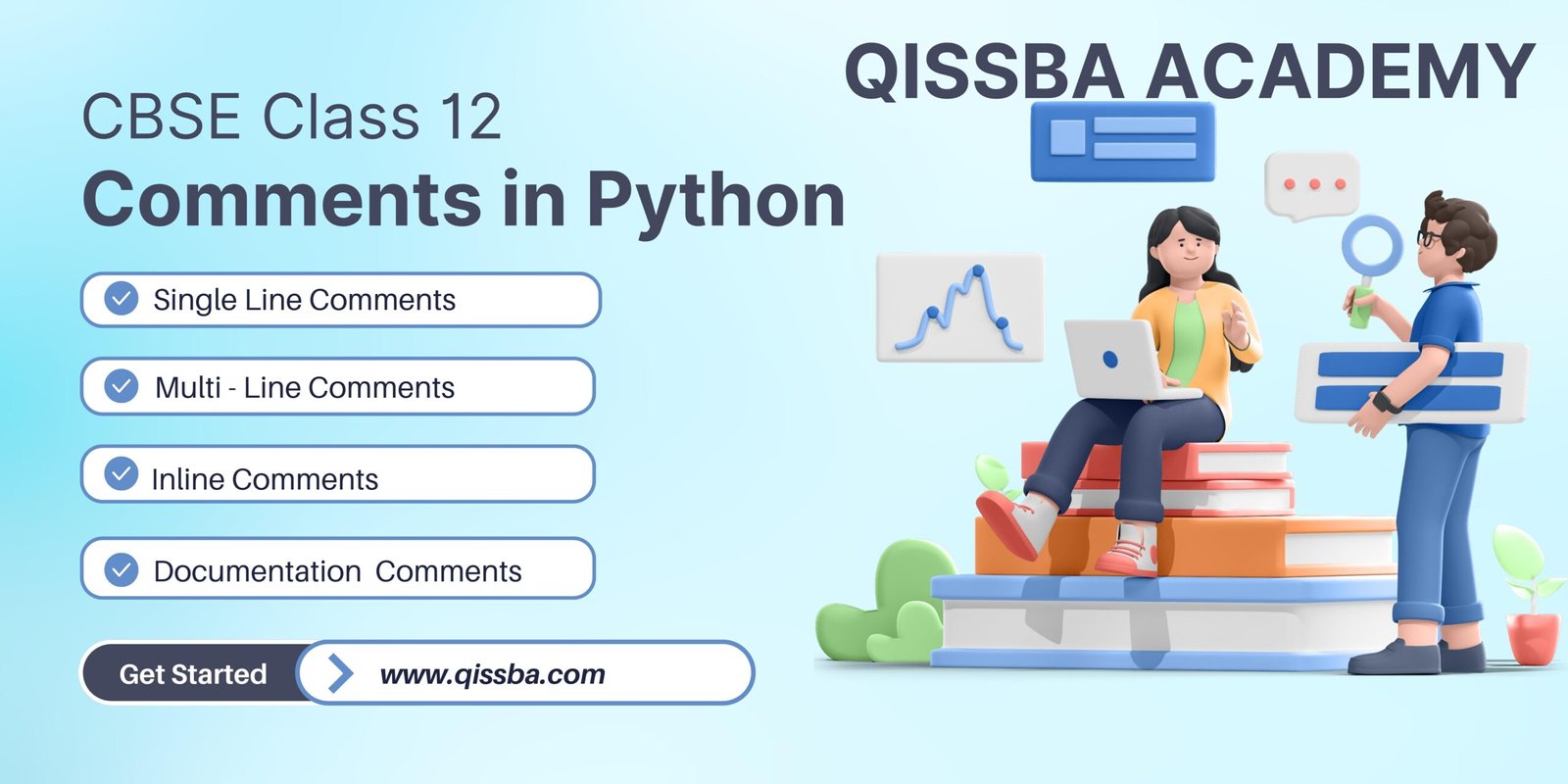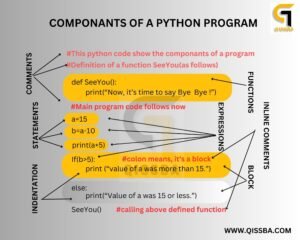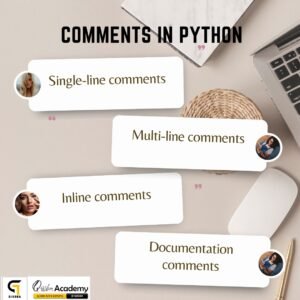
Comments in Python | CBSE Class 12
Introduction
Comments are lines of text that are ignored by the Python interpreter when we execute a program. Comments are used to provide additional information about the code, explain complex logic, or describe the purpose of a specific block of code. Comments are preceded by the hash symbol (#) in Python and can be placed on a separate line or at the end of a line of code.
It means Comments in python are the additional readable information, which is read by the programmers but ignored by Python interpreter. In Python, comments begin with symbol # (Pound or hash character) and end with the end of physical line.

Types of comments in Python?

In the above code, you can see four types of comments:
Single Line Comment:
Single-line comments are the most common type of comment in Python. They are used to provide a short description of the code on a single line. Single-line comments start with the hash (#) symbol and are placed at the beginning of the line. Any text that follows the hash symbol on the same line is treated as a comment and is ignored by the Python interpreter.
The physical lines beginning with # are the full line comments. There are three types of full line comments in python:
- # This program shows a program” s components
- # Definition of function see you () follows
- # Main program code follows now
Inline Comment:
The fourth comment is an inline comment as it starts in the middle of a physical line, after Python code (see below)
if b > 5: # colon means it requires a block
Inline comments are used to provide comments within a single line of code. They are useful for explaining complex code or providing additional information about a specific operation. Inline comments start with the hash symbol (#) and are placed at the end of the line of code.
Multi Line Comment:
Multi-line comments are used to provide longer descriptions of the code or to add comments to multiple lines of code. In Python, multi-line comments are created using triple quotes (‘ ‘ ‘ or ” ” “). Anything that is enclosed within triple quotes is treated as a comment and is ignored by the interpreter.
What if you want to enter a multi- line comment or a block comment? You can enter a multi – line comment in Python code in two ways:
Add a # symbol in the beginning of every physical line part of the multi- line comments, e.g.,
# Multi-line comments are useful for detailed additional information.
# Related to the program in question.
# It helps clarify certain important things.
Type comment as a triple – quoted multi-line string e.g.,
” ” “ Multi-line comment are useful for detailed additional information related to the program in question. It helps clarify certain important things
” ” “
This type of multi-line comment is also known as docstring.
You can either use triple – apostrophe ( ” ” ” ) or triple quotes ( ‘ ‘ ‘ ) to write docstrings. The docstring are very useful in documentation -and you “II learn about their usage later.
Documentation comments
Documentation comments are used to provide detailed information about a module, class, or function. They are often used to generate documentation for Python code using tools like Sphinx. Documentation comments start with a triple quote ( ‘ ‘ ‘ or ” ” “ ) and are placed directly below the module, class, or function definition.
Why are comments important in Python?
Code documentation: Comments serve as a form of documentation for your code. By providing explanations and notes about your code, you make it easier for other developers to understand and modify your code in the future.
Improved readability:
Comments improve the readability of your code by breaking it down into smaller, more manageable chunks. By using comments to separate your code into logical sections, you can make it easier for others (and yourself) to read and understand the code.
Debugging:
Comments can be used to identify and troubleshoot issues in your code. By adding comments to specific lines or blocks of code, you can make it easier to identify the cause of errors and fix them quickly.
Collaboration:
Comments make it easier for multiple developers to work on the same codebase. By providing clear explanations and notes about your code, you can make it easier for others to contribute to the project and maintain the codebase over time.
How to write effective comments in Python?
Use clear and concise language:
Your comments should be easy to read and understand. Use simple language and avoid technical jargon or abbreviations that may be unfamiliar to other developers.
Comment frequently:
Commenting frequently can help ensure that your code is easy to read and understand. Try to add comments to each function, loop, or block of code that performs a specific task.
Use descriptive comments:
Your comments should describe the purpose of the code and provide context for other developers. Use descriptive comments that explain the what, why, and how of your code.
Avoid unnecessary comments:
While comments are important, too many comments can make your code harder to read. Avoid adding comments that simply repeat the code or state the obvious.
————————————————————————————————————————————————–
Exam Time
————————————————————————————————————————————————-
Here are some important questions on Python comments that you may find helpful in CBSE exams 2023:
Q1: What are comments in Python, and why are they important?
Q2: What are the different types of comments in Python?
Q3: How do you add a single-line comment in Python?
Q4: How do you add a multi-line comment in Python?
Q5: How do you add an inline comment in Python?
Q6: What are documentation comments in Python, and how are they used?
Q7: How do you use comments to make your code more readable and maintainable?
Q8: What are some best practices for using comments in Python?
Q9: How do you remove comments from your Python code?
Q10: Can comments affect the performance of a Python program?
Also Read…
PYTHON : KEYWORDS
PYTHON : IDENTIFIERS
PYTHON : LITERALS
Tag:Adding comments to Python code, Code documentation in Python, Commenting best practices in Python, Inline comments in Python, Multi-line comments in Python, Purpose of comments in Python, Removing comments from Python code, Single-line comments in Python, Syntax for comments in Python, Using comments for readability in Python


